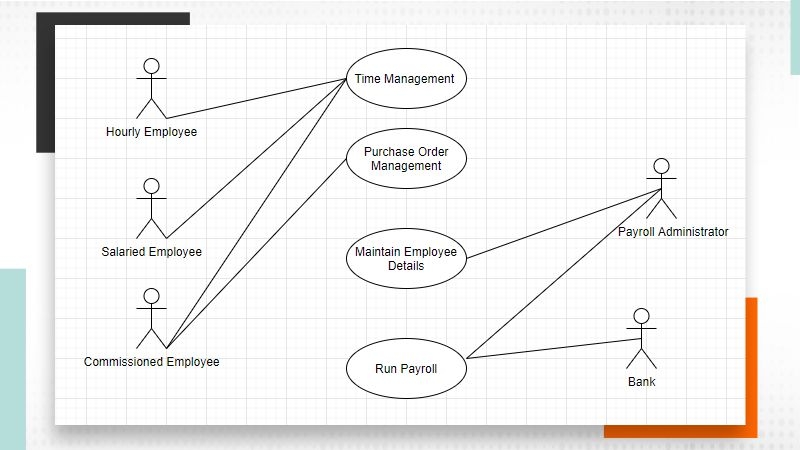19
SepGrab Deal : Upto 30% off on live classes + 2 free self-paced courses - SCHEDULE CALL
In the world of UML, use case diagrams are very famous. And especially from the time when agile took over the industry, they are going like crazy. But I still feel there is lots of confusion pertaining to use case diagrams, use case diagrams in UML, different examples for use case diagrams.
But with this blog, I will help you to understand this in a much-simplified way, where I will take different examples for use case diagrams, use case diagrams tools, and various other verticals revolving around it.
For things to be more clear to you I would recommend, visit our UML blog so that you have a basic understanding of it and how we will deep dive to understand use case diagrams.
Holding the fact that in maximum events use cases get misunderstood furthermore analysts tend to attach multiple things in use case diagrams. However, such is not the plight, it starts at a pretty huge level and is totally dependent as per the necessities.
In general, the layout with a directional slant, changing in the creation and a conducting phase determines the use case diagrams.
People illustrate the range of a framework utilizing entertainers and use cases. Use cases hold a group of activities, administrations, plus capacities that the core needs to function. Right now, "framework" is something living to be designed or operated, for instance, a site. The "characters" are individuals or elements working under characterized jobs inside the framework which help to establish a use case diagram, setting up the relationship between system and actors.
A utilization occurrence graph is generally straightforward. It doesn't bestow the fraction of the utilization problems:
As I already said, the combination in use case diagrams is done amidst just a couple of shapes and is very basic in nature. On the off chance that yours contain in excess of 20 use cases, you are presumably abusing use case outline.
Learn Business Analyst in the Easiest Way

We all are aware of producing use case diagrams online or by the assistant of any use case diagrams tools. Either we browse for some free tools or just download any current use case diagram tools. But do you think use case diagrams came into existence only with the IT revolution and with the internet?
In 1986, Ivar Jacobson initially planned literary, auxiliary, and observed displaying procedures for designating use cases. In 1992 his co-created writing assisted with advancing the procedure for catching practical necessities, particularly in programming advancement. Initially, he had utilized the heads utilization situations and practice crisis – the last an immediate interpretation of his Swedish expression – however, he pronounced that not of these cycles appeared normal in English, and in the long run, he chose use case.
On a very high level, use case diagrams are being used to define the dynamic nature of the requirements, but then many analysts consider this as too generic. The reason being other diagrams in UML also can be related to this definition. So to be precise use case diagrams UML, are being used during the initiation of the project and in the very early stage.
They help to acquire all the requirements keeping internal and external influences intact.
So what all could be key points for this -

There are multiple notations that can be used in use case diagrams, but mostly it's actors and use cases that are being used.
Use Cases
Use cases are utilized to speak to significant level functionalities and how the client will deal with the framework. A utilization case speaks to an unmistakable usefulness of a framework, a segment, a bundle, or a class. It is meant by an oval shape with the name of a utilization case composed inside the oval shape.
Actors
It is utilized inside use case charts. The on-screen character is a substance that associates with the framework. A client is the best case of an entertainer. An entertainer is an element that starts the utilization case from outside the extent of a utilization case. It very well may be any component that can trigger communication with the utilization case. One on-screen character can be related to different use cases in the framework.

These notations help to outline the details of components of use case diagram in UML -
Business Analyst Training & Certification

As though any element can be broken down in use cases, and with the popularity of agile, every condition gets broken down into use cases and user stories. I must say this one has surely given a new life to UML. So out of those let’s see some use case diagrams examples -
All the above examples can be drawn by various mediums. Those could use case diagrams tools, or attracting use case diagrams online or by several available use case diagram creator. But whatever the medium or the platform, the logic would remain the same.
As though any element can be broken down in use cases, and with the popularity of agile, every condition gets broken down into use cases and user stories. I must say this one has surely given a new life to UML. So out of those let’s see some use case diagrams examples -
All the above examples can be drawn by various mediums. Those could use case diagrams tools, or attracting use case diagrams online or by several available use case diagram creator. But whatever the medium or the platform, the logic would remain the same.
Let’s see a pattern of an airline reservation model!

Another example of the use case diagram - Simple Payroll System

When you wish to have a glance at the use case diagram in, the beginning one needs to glance at the complete method mindfully. Be sure that you cover every checkpoint of the working body. Missing anyone could lead to multiple processes and functions break impacting the project. Once, the working piece of fabrication is detected, by then these processes are changed over into multiple application containers that wish to be applied in the use case plot.
A use case is only a center supportiveness of any working body. In the wake of filtering through the use cases, we need to choose the unmistakable on-screen characters or things that will interface with the framework. These on-screen characters are in danger of bringing the accommodation of a framework. On-screen characters can be someone or something. It can also be a private part of a framework. These on-screen characters must be pertinent to the supportiveness of a structure they are cooperating with.
After the on-screen characters and use cases are enrolled, by then you need to investigate the relationship of a specific entertainer with the utilization case or a framework. One must see the all-out number of ways an entertainer could associate with the framework. A solitary entertainer can connect with various use cases simultaneously, or it can collaborate with various use cases at the same time.
Few Basic Rules concerning this can be
Business Analyst Training & Certification

Importance of Use Case Diagram for the Project Team
By now you might have the clarity of what wonders use case diagrams can do for the project development, and how important they in terms of understanding the requirements. Let’s see its importance from the eyes of different stakeholders -
Business Analyst/Product Analyst
Development Team
Testing Team
Get a better insight into the requirement that helps in writing the test cases.
The test cases and requirements are synced to ensure the delivered product works as per expectation.
The use diagram always focus on core functionalities and are capable to behave dynamically. Hence, they are very popular and powerful tools. When you break down the requirements in the form of use cases, it eases out the solution approach and makes it easy to understand. Try this wonderful tool of UML, and see what magic it would bring to your business needs. Hoping you had a great experience reading this. Happy Learning Learners!!
 Pinterest
Pinterest
 Email
Email
The JanBask Training Team includes certified professionals and expert writers dedicated to helping learners navigate their career journeys in QA, Cybersecurity, Salesforce, and more. Each article is carefully researched and reviewed to ensure quality and relevance.

Cyber Security

QA

Salesforce

Business Analyst

MS SQL Server

Data Science

DevOps

Hadoop

Python

Artificial Intelligence

Machine Learning

Tableau
Search Posts
Related Posts
Understand The Background Of Business Analysis Documentation Now
![]() 12.2k
12.2k
Understanding Class Diagram in UML (Unified Modelling Language)
![]() 6.9k
6.9k
What is the Business System Analyst’s Salary?
![]() 299.8k
299.8k
Business Analytics Careers - Know Why They are in Great Demand
![]() 4.5k
4.5k
Here's What No One Tells You About Business Analysis Monitoring
![]() 3.9k
3.9k
Receive Latest Materials and Offers on Business Analyst Course
Interviews